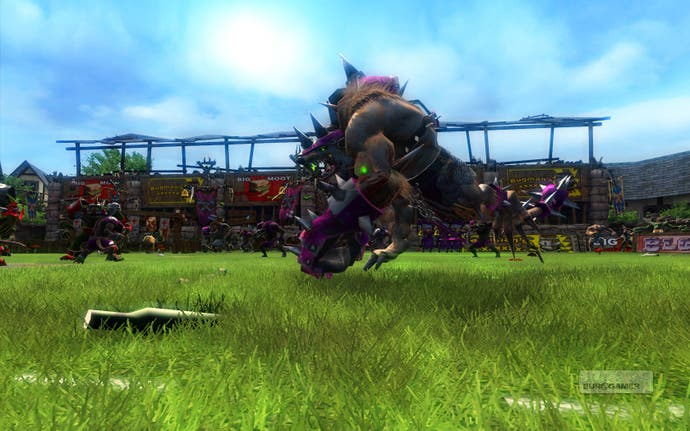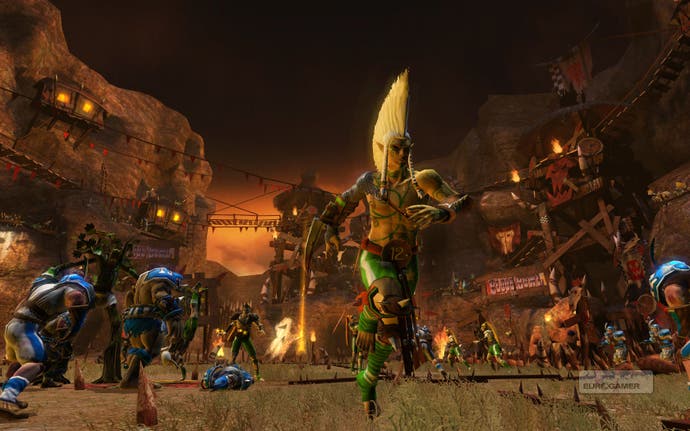Blood Bowl
Rolling defence.
Know what I hate? Elves. Maybe it's the fact that they remind me of the smug trustafarian hippies who plague Brighton's pubs and open spaces. Perhaps I'm jealous of their svelte, eternal youth and haughty attitude. Maybe it's because I'm basically a dwarf. Maybe it's because they just absolutely trounced me on the field, embarrassing my team of lumbering Orcs with their sublime grasp of the long-field passing game and elegant, darting runs and dodges.
I was doing pretty well up until then. A few games to get my head around the rules (Blood Bowl was one of the few branches of the Warhammer tree which I never scampered along in my youth) and I was playing relatively competently. The game's initially bewildering nature, compounded by a less-than-helpful tutorial, had been clarified – boiled down to a basic understanding of the blocking, tackling and risk-calculation which form the backbone of Blood Bowl's gameplay. It had gone from infuriating to fun in about half an hour. Unfortunately, my hands-down defeat by the prancing wood ninnies sent my petulantometer swinging wildly back the other way.
Blood Bowl is American Football at its core, with the more complex rules and frequent stoppages stripped out and replaced with brute violence and Games Workshop's stock fantasy races. Each race represents an accepted tactical approach to the real-life game - with Elves embodying a fluid, passing play-style, the Skaven personifying speed, Orcs the power game and so on. Focusing on these advantages and the weaknesses of your opposition is fundamental to success.
In the turn-based version of the game, coaches move each of their players around the field one by one, or make tackles and blocks against opposition members in adjacent grid squares. Each turn, one player can "blitz": both moving and tackling in one turn to offer a shock-tactic advantage. Almost every action requires a dice roll: moving through tackle zones, attempting a pass, trying to make a block. Failing a roll results in a "turnover", with play switching to the opposition.

Each match consists of 16 of these turns for each player, eight in each half. Wins are based on points from touchdowns, although the regularity of injuries, knock-outs and even fatalities means that grinding opponents into dust before strolling in a last-turn touchdown is a very valid tactic.
Building a basic strategy around the strengths of your team isn't hard to do, and settling on the Orcs as a tough, physical beginners' set-up, I pick up the ropes pretty quickly. I learn a few of the basic manoeuvres and terms early on, setting up "cages" for my ball-carrier by surrounding him with rugged blockers and blitzers and shuffling him toward the end zone. Switching up the formations at each kick-off to overload flanks or cripple key players serves me well too, although my trusty Greenskins find the more flamboyant or advanced tactics beyond them.

However, I soon start to find the AI wanting. Tactics are predictable and occasionally curiously inappropriate. Fragile teams will sometimes attempt to attempt to trade casualties with a physically superior side, and clumsy brutes will try and string together graceful runs and long passes. Annoyingly, this quite often works, with supposedly ham-fisted players pulling off feats of incredible agility and lean and lithe beanpoles felling blitzers three times their size. It all feels a bit random.


